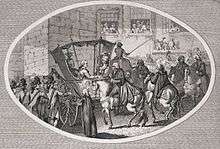William Pickett (alderman)

William Pickett (died 1796) was an English goldsmith and local politician, Lord Mayor of London in 1789.[1]
Goldsmith
Pickett was in business as a goldsmith on Ludgate Hill from 1758, initially a partner in Thead & Pickett. From 1768 to 1777 he traded under his own name. From 1777 Philip Rundell was a partner with him in Pickett & Rundell.[2]
In 1786 Rundell bought out Pickett, and within about a year the firm became Rundell and Bridge, the dominant London goldsmiths for half a century.[3]
Politician
Pickett was elected alderman of Cornhill Ward in 1783.[4] In London's Court of Alderman he belonged to the Whig group, opposed to the government of William Pitt the younger in the 1790s.[5] In 1787, at the request of local traders, he campaigned for the removal of Temple Bar, but without success.[6] While this scheme for street widening was thrown out, Pickett did succeed with another, near the Strand in the area of St Clement Danes.[7] The resulting new Pickett Street was only called for that name for a short while, the traditional name Strand prevailing.[8] The new development was demolished in 1870, to make way for the Royal Courts of Justice.[9]
A reforming Lord Mayor for 1789, Pickett then stood as a parliamentary candidate, for the City of London, in 1790. Without a political organisation he came bottom of the poll. He stood again in 1796, as an opponent of the sedition bills, with little more success.[10]
Death
Pickett was buried in the family vault in Stoke Newington on 24 December 1796.[11]
Family
He married Elizabeth Pratten.[12][13] Other sources say he married the daughter of his partner Thead.
Notes
- ↑ Benjamin Brogden Orridge (1867). Some Account of the Citizens of London and Their Rulers, from 1060 to 1867. W. Tegg. p. 248.
- ↑ Worshipful Company of Goldsmiths (1935). the london goldsmiths. CUP Archive. p. 70. GGKEY:S69DNE1FJTC.
- ↑ Culme, John. Oxford Dictionary of National Biography (online ed.). Oxford University Press. doi:10.1093/ref:odnb/37923. (Subscription or UK public library membership required.)
- ↑ Edmund Burke (1807). Dodsley's Annual Register. J. Dodsley. p. 68.
- ↑ Beaven, Alfred B. (1908). "The Aldermen of the City of London temp. Henry III.-1908. With notes on the parliamentary representation of the city, the aldermen and the livery companies, the aldermanic veto, aldermanic baronets and knights, etc.". Internet Archive. London: E. Fisher & Company. p. lviii. Retrieved 28 June 2015.
- ↑ Theophilus Charles Noble (1870). Memorials of Temple Bar; with some account of Fleet Street, and the parishes of St. Dunstan and St. Bride, London. p. 32.
- ↑ Jerry White (28 February 2013). A Great and Monstrous Thing. Harvard University Press. p. 78. ISBN 978-0-674-07640-2.
- ↑ Walter Thornbury, 'St Clement Danes: The law courts', in "Old and New London": Volume 3 (London, 1878), pp. 15-25 http://www.british-history.ac.uk/old-new-london/vol3/pp15-25 [accessed 23 June 2015].
- ↑ Brian Girling (30 September 2013). Lost London in Colour. Amberley Publishing Limited. p. 110. ISBN 978-1-4456-1512-7.
- ↑ "London (1790–1820), History of Parliament Online". Retrieved 28 June 2015.
- ↑ Daniel Lysons (1811). The Environs of London: Kent, Essex, and Herts. T. Cadell and W. Davies. p. 574.
- ↑ The Monthly Magazine. Sherwood, Gilbert and Piper. 1796. p. 910.
- ↑ The Gentleman's Magazine. A. Dodd and A. Smith. 1797. p. 459.